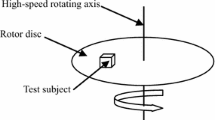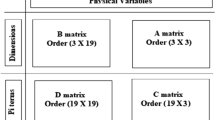Abstract
Rotor-bearing systems play a vital role in machine tools, aero engines, and wind turbines. Generally, worn-induced degradation quantities and manufacturing errors of components are the main error sources that influence the precision reliability of rotor-bearing systems. The current precision reliability evaluation models are focusing on several error sources in only a few key components without agreeable results. Therefore, a precision reliability evaluation model is proposed considering all time-variant error sources and random error sources. Firstly, time-variant wear models for commonly occurred degradation types in a rotor-bearing system are developed. Secondly, the constructed time-variant wear models are inserted into the precision model with all moving components in the rotor-bearing system using meta-action structural decomposition method. Finally, the time-variant stochastic process discretization method is employed to establish the precision reliability evaluation model, and solve the precision reliability of the rotor-bearing systems. Case investigations are carried out to verify the performance of the present model, which provides a more accurate precision reliability evaluation model to estimate the conditions of rotor-bearing systems during the service period.













Similar content being viewed by others
References
Sukhija RP, Rao AC (1986) Mechanical error synthesis of path generating mechanisms using reliability index. T Can Soc Mech Eng 10(2):85–90
Kong XF, Yang J, Hao SH (2021) Reliability modeling-based tolerance design and process parameter analysis considering performance degradation. Reliab Eng Syst Safe 207:107343
Tavangar M, Hashemi M (2022) Reliability and maintenance analysis of coherent systems subject to aging and environmental shocks. Reliab Eng Syst Safe 218:108170
Tang H, Duan JA, Lan SH, Shui HY (2015) A new geometric error modeling approach for multi-axis system based on stream of variation theory. Int J Mach Tools Manuf 92:41–51
Yang JX, Ding H (2016) A new position independent geometric errors identification model of five-axis serial machine tools based on differential motion matrices. Int J Mach Tools Manuf 104:68–77
Bozca M (2018) Transmission error model-based optimisation of the geometric design parameters of an automotive transmission gearbox to reduce gear-rattle noise. Appl Acoust 130:247–259
Liu Y, Wan M, Xiao QB, Zhang WH (2019) Identification and compensation of geometric errors of rotary axes in five-axis machine tools through constructing equivalent rotary axis (ERA). Int J Mech Sci 152:211–227
Yang WJ, Liu XJ, Guo XT, Lu WL, Yao ZJ, Lei ZL (2021) A method for simultaneously measuring 6DOF geometric motion errors of a precision rotary stage based on absolute position-distance measurement. Opt Laser Eng 138:106420
Wang K, Zhou CG, Ou Y, Feng HT (2022) Investigation of the transmission accuracy of ball screw considering errors and preloading level. Int J Adv Manuf Technol 118:3917–3932
Zhang GB, Lou JH, Li DY, Peng L (2015) Fault diagnosis study of complex mechanism based on FMA function decomposition model. Procedia CIRP 27:176–180
Yu H, Zhang GB, Ran Y, Li MQ, Jiang DX, Chen YQ (2020) A reliability allocation method for mechanical product based on meta-action. IEEE T Reliab 69(1):373–381
Wang ZC, Ran Y, Yu H, Jin CX, Zhang GB (2021) Failure mode and effects analysis using function–motion–action decomposition method and integrated risk priority number for mechatronic products. Qual Reliab Eng Int 37(6):2875–2899
Wang ZC, Ran Y, Yang X, Li XL, Chen YF, Zhang GB (2021) Primary failure mode and effects analysis with function-motion-action hierarchy structure for mechatronic systems. Eng Fail Anal 130:105775
Mu ZY, Ran Y, Zhang GB, Wang HW, Yang X (2021) Remaining useful life prediction method for machine tools based on meta-action theory. P I Mech Eng O-J Ris 235(4):580–590. https://doi.org/10.1177/1748006X211002544
Chen YF, Ran Y, Wang ZC, Li XL, Yang X, Zhang GB (2021) Meta-action reliability-based mechanical product optimization design under uncertainty environment. Eng Appl Artif Intel 100:104174
Yang X, Ran Y, Zhang GB, Wang HW, Mu ZY, Zhi SG (2022) A digital twin-driven hybrid approach for the prediction of performance degradation in transmission unit of CNC machine tool. Robot Cim-Int Manuf 73(1):102230
Xiao LM, Huang GQ, Zhang GB (2022) Toward an action-granularity-oriented modularization strategy for complex mechanical products using a hybrid gga-cga method. Neural Comput Appl 34(8):6453–6487
Huang XZ, Hu S, Zhang YM, Xu YC (2015) A method to determine kinematic accuracy reliability of gear mechanisms with truncated random variables. Mech Mach Theory 92:200–212
Cai LG, Zhang ZL, Cheng Q, Liu ZF, Gu PH, Qi Y (2016) An approach to optimize the machining accuracy retainability of multi-axis NC machine tool based on robust design. Precis Eng 43:370–386
Wang W, Zhang YM, Li CY (2017) Dynamic reliability analysis of linear guides in positioning precision. Mech Mach Theory 116:451–464
Zhang ZL, Liu ZF, Cai LG, Cheng Q, Qi Y (2017) An accuracy design approach for a multi-axis NC machine tool based on reliability theory. Int J Adv Manuf Technol 91(5–8):1547–1566
Yang X, Ran Y, Wang ZC, Mu ZY, Zhang GB (2021) Early prediction method for assembly precision of mechanical system and assessment of precision reliability. Int J Adv Manuf Technol 112:203–220
Ma XX, Zhang ZG, Hua HX (2022) Uncertainty quantization and reliability analysis for rotor/stator rub-impact using advanced Kriging surrogate model. J Sound Vib 525:116800
Wang W, Shen G, Zhang YM, Zhu ZC, Li CY, Lu H (2021) Dynamic reliability analysis of mechanical system with wear and vibration failure modes. Mech Mach Theory 163:104385
Chen JH, Chen LM, Qian LF, Chen GS, Zhou SJ (2022) Time-dependent kinematic reliability analysis of gear mechanism based on sequential decoupling strategy and saddle-point approximation. Reliab Eng Syst Safe 220:108292
Jiang S, Li W, Xin GF, Sheng LC, Wang YQ (2022) Study on dynamic reliability of permanent magnet gear transmission system with wear and failure correlation. Eng Fail Anal 131:105802
Zhang XG, Li YL, Ran Y, Zhang GB (2020) Stochastic models for performance analysis of multistate flexible manufacturing cells. J Manuf Syst 55:94–108
Pan ZQ, Balakrishnan N (2011) Reliability modeling of degradation of products with multiple performance characteristics based on gamma processes. Reliab Eng Syst Safe 96(8):949–957
Cheng YW, Zhu HP, Hu K, Wu J, Shao XY, Wang YH (2019) Reliability prediction of machinery with multiple degradation characteristics using double-Wiener process and Monte Carlo algorithm. Mech Syst Signal Pr 134:106333
Andrieu-Renaud C, Sudret B, Lemaire M (2004) The PHI2 method: a way to compute time-variant reliability. Reliab Eng Syst Safe 84(1):75–86
Moura MDC, Zio E, Lins ID, Droguett E (2011) Failure and reliability prediction by support vector machines regression of time series data. Reliab Eng Syst Safe 96(11):1527–1534
He JJ, Huang M, Wang W, Wang SH, Guan XF (2021) An asymptotic stochastic response surface approach to reliability assessment under multi-source heterogeneous uncertainties. Reliab Eng Syst Safe 215:107804
Jiang C, Qiu HB, Gao L, Wang DP, Yang Z, Chen LM (2020) Real-time estimation error-guided active learning Kriging method for time-dependent reliability analysis. Appl Math Model 77(1):82–98
Janakiraman V, Li S, Kahraman A (2014) An investigation of the impacts of contact parameters on wear coefficient. J Tribol 136(3):69–74
Jiang C, Huang XP, Wei XP, Liu NY (2017) A time-variant reliability analysis method for structural systems based on stochastic process discretization. Int J Mech Mater Des 13:173–193. https://doi.org/10.1007/s10999-015-9324-z
Lebrun R, Dutfoy A (2009) An innovating analysis of the Nataf transformation from the viewpoint of copula. Probabilist Eng Mech 24(3):312–320
Zhang ZL, Cheng Q, Qi BB, Tao ZQ (2021) A general approach for the machining quality evaluation of S-shaped specimen based on POS-SQP algorithm and Monte Carlo method. J Manuf Syst 60:553–568
Funding
This work was supported by the National Natural Science Foundation of China (No. U1909217), the Zhejiang Natural Science Foundation of China (No. LD21E050001), and the Wenzhou Major Science and Technology Innovation Project of China (No. ZG2021019, ZG2021027).
Author information
Authors and Affiliations
Contributions
All authors contributed to the study conception and design. Material preparation, data collection, and analysis were performed by Hongwei Wang, Jiawei Xiang, and Yulong Li. The first draft of the manuscript was written by Hongwei Wang, and all authors commented on previous versions of the manuscript. All authors read and approved the final manuscript.
Corresponding author
Ethics declarations
Competing interests
The authors declare no competing interests.
Additional information
Publisher's note
Springer Nature remains neutral with regard to jurisdictional claims in published maps and institutional affiliations.
Rights and permissions
About this article
Cite this article
Wang, H., Xiang, J., Zhao, X. et al. A kinematic precision reliability evaluation method for rotor-bearing systems considering multi-source wear degradations and random errors. Int J Adv Manuf Technol 124, 4159–4173 (2023). https://doi.org/10.1007/s00170-022-09383-x
Received:
Accepted:
Published:
Issue Date:
DOI: https://doi.org/10.1007/s00170-022-09383-x




